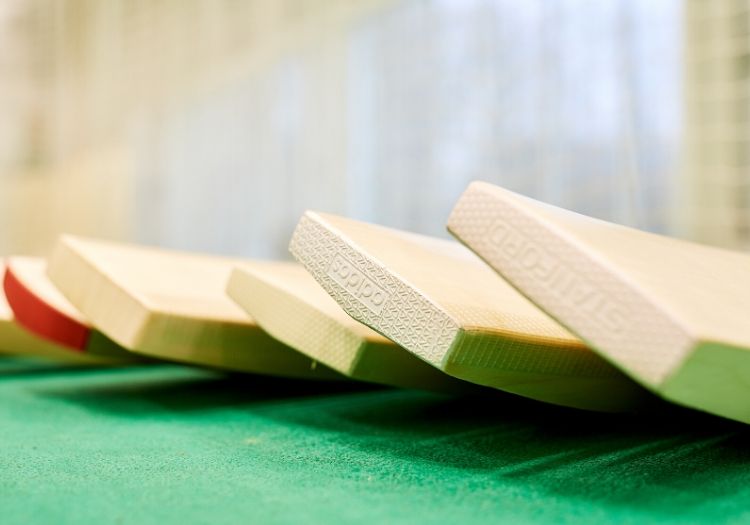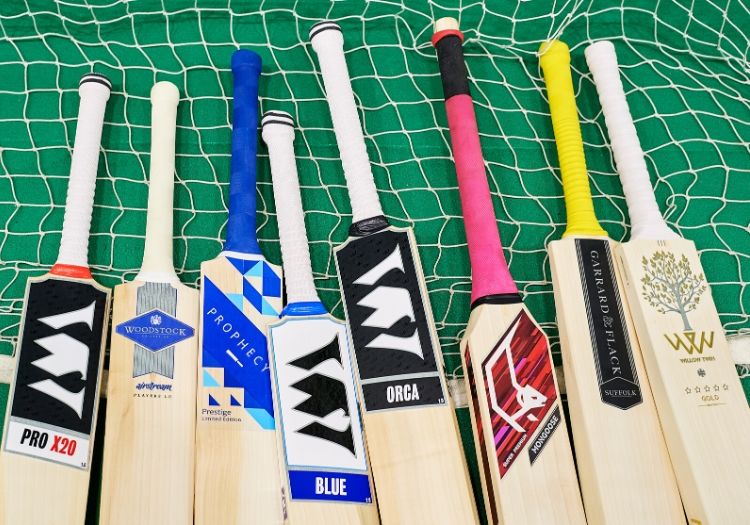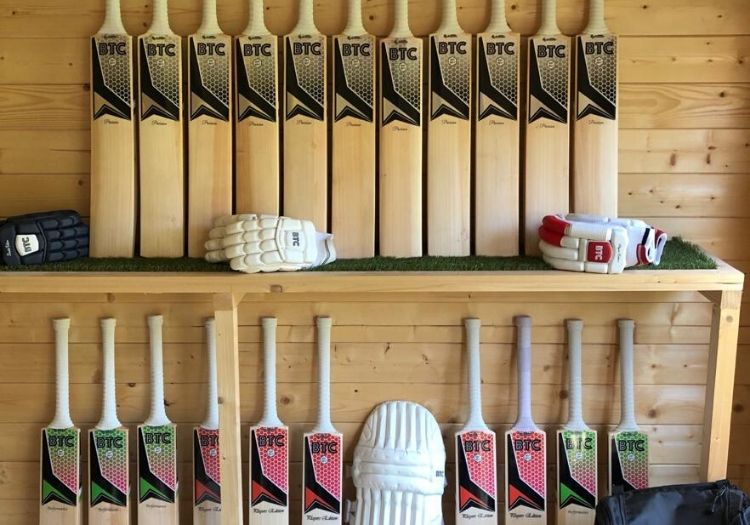NICK FRIEND: With cricket at a halt, the sales pattern has followed. Three independent bat-makers explain the toll of Covid-19 on business, how they are getting by and how social distancing measures could force them to change the way they work

For independent bat-makers, Christmas normally comes in late spring and early summer. For many club cricketers, it is an annual pre-season pilgrimage – the journey into the countryside to hand-select their poison for the months ahead. One player arrives at training armed with a new piece of willow from an up-and-coming brand and others soon follow.
Instead, the phone has stopped ringing.
The equation is straightforward enough: where there is no cricket, there is less need for a new blade – less opportunity to become frustrated with last year’s weapon of choice, less chance of cracks occurring, less impulse to make a spontaneous purchase.
Cricket is stuck both at the forefront and the back of the nation’s minds: it is missed, of course; but it is not there. And so, with that reluctant acceptance, every little piece of the game is affected in one way or another.
“For this time of the year, it would normally be my busiest time, but it has turned probably into one of our quietest times ever,” says Ed Garrard, who owns Garrard and Flack, functioning out of a workshop at his home in Suffolk.
“But then, as lockdown has continued, enquiries did actually start to pick up. We started to get a few enquiries from people asking when this is all over if they can come and visit us.
“My biggest worry would be if there’s no cricket at all this year, how many people are going to be coming round in March next year wanting to get a new bat because they didn’t break their bat this year?”
He is one of three independent brand owners that spoke to The Cricketer for this piece; in each case, the story was the same, their tales featuring a mixture of concern, pragmatism and cautious optimism.
The worst-case scenario for any business is closure, but all three expect to come through this and out the other side intact, even if these unique times have seen sales temporarily plummet – the reasons clear but frustrating, nonetheless.
“If you’ve got no money coming in and orders do dry up or the buyers of clefts want to look after their money and their longevity, it has a massive impact. I do worry about that,” adds Mike Kennedy, who runs World Class Willow. The company began as a provider of clefts to bat-makers, before venturing into producing their own bats more recently.
“Do I look at it in terms of getting ready for next year? Hopefully, yeah. It’s just very frustrating. I had a big contract lined up making for some pros for another company, and unfortunately because they’re in the same predicament, they couldn’t commit. It’s like: ‘Crikey.’ I know you shouldn’t count your chickens before they hatch, but sometimes in business you have to. You never expect this, do you?”
Reece Morris, owner of BTC Cricket, has experienced a similar situation. Aged just 21 and with the business in its third full year, he had seen increased interest in his kit, with prospective buyers – both amateur and professional players – visiting his workshop and approaching him. For a young brand, the initial spurt was a confidence boost – a sign that he was doing the right things.

Business has shown signs of picking up gradually since nets were reopened
Overseas players anticipating their arrival in the United Kingdom ahead of this summer and others returning from seasons abroad had also made contact. And then coronavirus struck, cricket was cancelled, lockdown ensued and the immediate need for kit vanished.
“It was looking really promising,” he reflects with a wry chuckle, “so I had to start making a load of bats up to try to compete with what was going to be a rush, which was fantastic and I was really excited about that.
“Some of those were new areas for me; I hadn’t necessarily had interest before from where some of those people were coming from – guys who could help me get my brand out there.
“And then suddenly, as soon as that announcement came of the season being put on hold, it’s the messages you then get. ‘Obviously, the season’s on hold now, so I’m going to hold fire on the kit. I hope you understand.’ And obviously you do, you understand completely.
“I had no issues with it, but from suddenly having that excitement that there are going to be loads of people wanting to come and pick their new kit out [you go] to almost effectively a standstill.”
In the first few weeks after it was announced that recreational cricket was to be suspended until further notice, Morris’ sales amounted to a pair of new pads and gloves, as well as a set of kit that had already been in the pipeline. Encouragingly, numbers have begun to pick up once more since restrictions were lifted on the use of nets.
“In terms of sales, it has had a massive effect,” he adds. “People aren’t going to be willing to spend money on new kit for the season when you don’t know if it’s going to be used or if there is going to be cricket played, which you completely understand. To be quite honest, if I didn’t own a brand and I needed new kit, would I go out there and buy kit when I didn’t necessarily need it? Probably not.
“But we will get through it and at the moment I’m just enjoying making a load of bats. Me and dad are looking to put an extension on the shed as well, just to make it a little bit bigger for some more kit to go in. There are more important things – everyone’s health.”
If there is a positive, it is that cricket will return. And when it does, cricketers will need cricket bats. For, in whichever way the game evolves, that simple fact will never change. There, too, is the hope that money saved by individuals in this period might then allow for an investment in new kit when the time comes, and that when next year’s pre-season nets begin, the sheer excitement might incite an additional wave of purchases.
As a result, this period has become a manufacturing opportunity – even if that brings about its own challenges for those who do the majority of their work to order.
“I’m leaving a little bit more wood on the bats at the moment,” says Kennedy, who is using the time to develop his product as well. “If I can crack on and get a load done, if there’s one in that stock that potentially that person wants, then we can make some minor adjustments so it suits them and fits their game.
“I’ve been working on a few pro bats, getting a good amount of them done up and getting them put to one side for them.”

World Class Willow (far left and middle pair) and Garrard and Flack (second from right) on display
Garrard and Morris both have their workshops at home, an advantage in terms of running costs at a time of limited return, while Kennedy – only a matter of weeks before Covid-19 reared its head – had taken on a 2,000-square-foot workshop and shop in a move that has upped his overheads.
The upshot is that as and when cricket’s resumption brings about an upsurge in enquiries and orders, all three will be prepared for whatever level of demand might come.
“I’d say that we’ll be ready to go straight away, but it depends on what time of year it is,” Garrard explains. “If we do get going on July 1, I’d like to think that people will still want to buy a bat for this year because they’d still have half a season. But really, if you’ve only got five games, are you really going to buy new pads and gloves?
“I don’t think it would ever get to the stage where we have to say: ‘Right, we’re packing up.’ I wouldn’t even hope to think that we’d get that far down the road.”
He is already looking at ways that his business operations might have to change. Like many independent bat-makers, one of Garrard and Flack’s unique selling points is the invitation for customers to choose their custom-made product first-hand at his workshop.
While social distancing remains in place, he is well aware that the offering may not be possible. “I don’t know how the world is going to be afterwards,” he says. “We’ve got quite a small premises and actually keeping two metres apart in our workshop is going to be quite difficult.”
He suggests that diversifying into Skype and Zoom appointments – a virtual bespoke offering, if you will – could become the done thing, even if he knows that it is not quite the same as physically picking the bat up. Likewise, rather than selling products on his website through general images, Garrard is considering uploading photos of each specific bat in stock.
“We’ll perhaps get more into selling the bats individually,” he expands, “taking a picture of the bat that we’ve got in stock and selling it as a stock bat, so that people can actually look at a bat and go: ‘It’s got however many grains, it’s 2lb 8oz, it’s got an oval handle,’ rather than just clicking on a website asking for a 2lb 8oz bat.
“Even though it isn’t bespoke, they’re still getting an idea of what that actual bat is going to look like when it turns up at the door rather than going for a generic picture on a website.”

One of the walls inside Morris' BTC Cricket home workshop
Needless to say, it is a complicated time in a portion of the industry that is easily forgotten at a moment like this. It was one of the motivations behind reaching out for this piece – the idea that those whose contributions to the cricketing sector are often unsung need their voices heard now more than ever. Some brands have considered upping marketing spend, but even that is a difficult call to make at the moment.
Pads, gloves and accessories are also proving to be something of a dilemma – for some whose orders were successfully shipped across from Asia before all else ground to a halt, they have stock but few buyers. For others, whose orders have not arrived, there will be additional concern if the game resumes without deliveries having turned up. And then, there is the welfare of the companies out in the subcontinent responsible for the production of this equipment.
One bat-maker raised the issue of potentially having to source additional bat handles, which are made out of cane, should he be unable to use his usual supplier in India.
To a degree, the pandemic may force 2021 to become 2020 – at least in terms of product ranges. In all likelihood, there will be a rollover of stickers and labels meant for this season’s selection remaining next year when hopefully the world – and the game – are able to return to a state of some normalcy.
The fear, though, is that not all will make it. “There are going to be a lot of brands that go under after this,” Kennedy believes. “That really worries me. Some of the best bat-makers are in this country. We need to educate the public about this and try to get them to support local businesses again. I worry for businesses; I worry for businesses that have moved away from their making process and buy in bats and then put stickers on.”
“It won’t be make or break, but it might be break or stay for some people,” adds Garrard. “It’s very difficult to say – if you’ve got large overheads. I guess it depends on how established you are really. It may slow down the guys who don’t manufacture themselves. They can’t get deliveries in, while we’re actually driving 40 miles up the road to pick our wood up.”
Among the current apprehension, however, that light at the end of the tunnel remains; there will never come a time when cricket does not need bats – at any level of the game. A level of optimism shines through.
“We’re always going to be in a good position as long as there’s cricket,” Kennedy finishes. “It’s just the uncertainty; normally you have a good idea. If you have a blazing hot summer, cricket is everything. It’s everything for me anyway; you start getting good sales, you can predict what’s going to be happening, where you want to go next.”
Save 30% when you subscribe to The Cricketer’s print & digital bundle. £35 for 12 issues